The Plan: To Cross China from the Deserts of East Turkestan (Taklamakan Desert Region and the Tian Shan Mountain Ranges to the Silk Road) and emerge across the Himalayas.
Duration: Approximately 50-60 days.
Cycling Route: 3200 kilometers / 1988 miles
East to West (Train to Urumqi 3700 kilometers, 36 hours)
HIMALAYAS X 2011 STATS:
MODE: MTB Mountain Bike
TOTAL DAYS: 45
DAYS ON: 38 days pedaling
DAYS OFF: 7 rest and injury days
ALTITUDE: N/A meters / feet of altitude change on course
DISTANCE: 3200 kilometers / 1988 miles
FOOD CONSUMED: 20 loaves of Nan bread, 2 kilograms of oatmeal with raisins, apricots and dates, 45 mega-packs of vitamins/minerals, 1.5 kilogram of Gatorade (making 50 liters)
6 jars of pickles, 10 liters of grazing Goat milk, 8 bowls of noodles/meat/fat, 2 kilograms of rice.
WEIGHT: Start 96 kilograms. 10 weeks cross-fit 85 kilograms. Completion weight 70 kilograms.
EQUIPMENT CARRIED: Northface Tadpole2 Tent, Thermarest Lite, 4-season down sleeping bag.
EQUIPMENT DAMAGED: Rear wheel split 360 degrees, repaired with block of wood, hammer and electrical PVC tape roll, 1 bicycle tube patch.
EQUIPMENT DAMAGED: Rear wheel split 360 degrees, repaired with block of wood, hammer and electrical PVC tape roll, 1 bicycle tube patch.
PHOTOS TAKEN: 1500
SONGS PLAYED: 14
TRAIN RIDES: 37.5 HOURS
FERRY: Incheon, South Korea to Tianjin, China
TRAIN RIDES: 37.5 HOURS
FERRY: Incheon, South Korea to Tianjin, China

In late June 2011, I started driving at 3:00am from Gangneung, Gangwon-do Province, South Korea across South Korea and arrived at 6:00am at the Incheon port. I was in time for the large passenger-freight Ferry scheduled to cross over the Sea of China, To travel onwards from the Korean port City of Incheon with 3,000,000 inhabitants across the sea that separates the Korean peninsula from mainland China's Tianjin City, home to 12,500,000 people! The passenger ferry was the cheapest option with a bicycle and camping equipment to reach China overland or sea, about 140,000 Won.
Getting to Beijing from Tianjin port was actually fairly simple but you needed to be persuasive to get into any public transportation. I needed to take a local bus from the Port of Tianjin into the city center, then transfer to a Bullet train into Beijing home to 21,500,000 people! The Chinese train personnel like to say, May-O (no) and I would reply, Cui ma! (yes). Be prepared to win the argument.
Beixingchao was a neighbourhood which I was the most familiar with navigating. Late nights or morning restaurants and bars were busy until 6:00am, and the back alleys with little signage presented some challenges to find my friend's apartment, but even then, 50 days later, I found the old bike chained to a lamp post, and knocked on Craig Kirk's door again, after cycling across China.
I want to share the view from between the train cars, this is where I stayed for a day and a half en route to Urumqi. My fellow train travelers both Uighur and Chinese, all were friendly and we all had the same goal to reach our distance destinations. I had no idea the train ride would take as long as it did, and the conditions, it was definitely one of the challenging situations I had to be patient enough to complete, no bathrooms, no food, I just kept drinking boiled water and sweat for hours and hours across the deserts of China. Here's a 1 minute video of conditions inside the train across China, now imagine being in this exact situation for 3700 kilometers or 36 hours, respectively. It's rough on the swelling legs and ankles, when I reached Urumqi, I began taking large horse pill sized aspirins 3x a day to thin the blood which pooled inside my legs and ankles. The physical condition improved once I was cycling again, outside of Urumqi, I spent about 3 days there with a host that hosted me in my recovery condition before leaving on the bicycle tour on my own again.
My overland train ride from Beijing to the destination city of Urumqi, in Xinjiang which is also known as East Turkestan by the local Uighur Turkic speaking, mostly Muslim inhabitants whose ancestors had crossed over the Silk Road through Kashgar, hundreds of generations ago from Turkey and the Middle East. In 2011, the year of my travels, the civil unrest in Urumqi had boiled over the previous year with violent clashes between the Uighur people and the ethnic immigating Chinese from the East. This summer, the police forces were visible in groups of 5-10 officers marching along streets in Urumqi and Korla, the cities all along the route were closely patrolled, but for my time here, I only had a few confrontations with any police authorities, not to say, Uyghurs had their lives dictated and closely controlled by these Chinese and co-participating Uighur police officers.
Individually, the Chinese and the Uyghurs were some of the friendliest people I have ever met on the road. Unfortunately, the Chinese developments in East Turkestan oil and mineral rich region come without a mutually-participating local Uyghur people involved in that development process. So, the new highway is indeed silk, cities are developing and growing with Chinese immigrating there, but it displaced the Uyghurs and this boiled over into civil unrest. As a visitor, I was treated with respect by Uyghurs and Chinese, but I witnessed the bullying Chinese police who enlist Uyghur officers to harass innocent people. It was much worse in this region for the Uyghur people when I read from the news and websites, the discrimination of Uyghurs continues to this day.
It's politically western China today, this wilder western edge containing the Taklamakan Desert and the Tarim Basin lay between the Tian Shan Mountains in the north and the Southern Silk Road (Marco Polo) in the South, the Taklamakan Desert runs between them, and the Tarim Desert Highway stretches (552 kilometers) between Luntai and Meifung. I chose the Tarim Desert Highway because of a family I stayed with over the weekend in Korla, their father and his friend had worked there for China Petrol companies and recommended the route directly across the desert. The desert highway route consists of undulating desert hills which have been conquered by smooth tarmac ashphalt roads with small patches of grassland alongside it, protecting from the entrenching desert sands. The highway is frequented by truckers hauling gasoline tankers mostly, or the highway is deserted for most of the 5 days and 552 kilometers I pedaled through there.
From Urumqi, the bicycle route follows a main highway south that crosses the Tian Shan Mountains. Finding adequate water resupply thins right out in the mountains, I had to ask truckers for refills from their thermos bottles. Many boiled their water on stoves, and often passing motorists would hand out a bottle of water. There were streams running in the Tian Shan mountains, and Uighur villages with mud brick houses, but they were off the highway and seen in the distance. Once I reached Korla, you enter a new city, and it was well developed with paved wide roads and apartment blocks, street food vendors on main boulevards. I met a family in Korla, and the father's were coworkers from China Petrol, they expalined the way through the Taklamakan Desert which I made part of my route towards the Tibetan plateau. I took a long approach to reach the Tibetan region south of the Taklamakan and Aksai Chin Mountains because I had no idea if my access south would be permitted or not.
Do it yourself front racks assembled in Beijing.
These sisters helped their parents and sold watermelons from this blue moto-truck.
Having a Map of China, helped ease navigation because it had Chinese characters and English. I could correlate between the highway signs and the map. It is also a great segway when talking to locals to refer to the map and to name all the places you have visited, and to point out where you are heading. They will sometimes make suggestions, and it engages everyone in conversation.
The Belt highway G314 was built right beside villages like this one.
A Mosque in Toksun small village. The G314 runs southwest from Urumqi, Xinjiang towards Khunjerab Pass, which is on the northern border of Pakistan. It is 1,948 kilometres (1,210 mi) in length. It goes southeast from Urumchi and south of Toksun it turns west and follows the north side of the Tarim Basin to Kashgar. // Source: [Wikipedia]
I visited a Chinese-themed park outside of Korla. My hosts all emigrated to this region from Eastern China. They were excellent and generous hosts! I saw the city developments, much like in Urumqi, developed by Chinese and populated by Chinese. In these settings, it would be easy to not see the plight of the Uyghur culture, whom have lived in this region for a much longer time.
My hosts and their families playing Mahjong by the man-made lake park in Korla.
See that soldier on the horse, I will do that on a bicycle over the next few months.
Uyghurs in East Turkestan were friendly and curious about my bicycle and tour ahead, I told them I was from Canada, there was little response, I would refer to my paternal grandmother and say ROMANIA! And I would always get a positive response from people along this section of the Silk Road. (: My grandmother was born in Satu Mare, capital of Satu Mare County, Romania. The Uyghur people reminded me of unknown distant relatives, and I received their welcome on this journey.
Modern asphalt highway built by the Chinese, the Belt Road or New Silk Road, and the Tian Shan Mountains, the surrounding deserts, contrasting with aquaducts and trees seen in the left of the above photo in the populated town of Luntai, north of the Taklamakan Desert.
The locals boil water and drink it. I suspect that thermophiles still exist in the post-boiled water that is distributed and widely available from plastic thermos bottles in small hotels, gas stations, truck drivers, etc. since I collected it to refill bottles randomly, I consumed the water and had explosive diarrhea, see above photo! The cure was concentrated ginseng in paper cartons of glass flasks available at local shops and pharmacies in larger cities. Ginseng, indeed cured my shits and helped me throughout the roughest parts of this journey. I also used the remedy in the Himalayas.
Bam! And a fly already there to cash in on it! I was hanging off bridges to launch these stomach eruptions into the culverts, this one got away too early!
Through the barb wire fence, and into the rocky desert field, this was my campsite location for the night. Fortunately, having the Thermarest, and there was a sandy bank near those shrubs, allowed me to sleep flat on the ground off the rocky surface. I would ride until dark and setup camp in places like this. The Tian Shan Mountains southern border is in the background of this photo.
Refreshments all the products are Made in China. I would buy their sweet tea bottles.
Road camp / Truck stop along the G314.
Rough living at it's best. The Uighur cook prepared meat dishes for truckers and myself.
This truck driver and I got along well, he understood some English and acted as a translator. Later in the evening when more local truckers gathered, we hung out together and talked before I went back to my tent for some sleep. The cook (on left with white cylinder hat) had a gas generator running to light his open air street restaurant. The meat he served there, was laying out all day in the sun.
The cook and road stop restaurant entrepreneur. He burned random branches and wood that washed or blew across fields adjacent to the highway.
I got along with everyone except one man, he wasn't in any of my pictures. He threw stones at my tent and over my head hitting the other tent building. Eventually, I confronted him and grabbed his shirt by his neck while others translated to cool off the situation. He was a redneck in these parts.
Truckers took time to test ride the bike, many asked where was my engine, suggesting still, that I needed to travel by motorcycle as it is so much faster than a bicycle.
Highway sign for Luntai. The road south from the G314 to the Tarim Desert Highway.
Local shop in Luntai. Definite must-stop before crossing the 552 kilometer Tarim Desert Highway.
With City officials in Korla, Turkestan.
Wonderful hosts in Korla, we met at a petrol station and I ended spending the entire weekend.
Street meats, no kidding there! Meat and bones out in the fresh air to view!
PART TWO of this Post:
Himalayan Bicycle Touring along the Tibetan plateau.
Further into the journey I cycled from Chengdu into the Himalayas. This is guest meal check in at a hostel. The group of cyclists I'm with are cycling to Lhasa, I woke from a wild camp in a field to see 10 cyclists all riding by above me. I flagged them down and joined their touring group en route.
Kangding, Gateway to Tibet.
The open rooftop of the Kangding Guest house / Hostel.
A professor and student I met from Fudong University, Shanghai
The professor and I walked up into the mountains surrounding Kangding City
Tibetan scripts, which should be better preserved and respected than this.
Local students on a school picnic.
Inside a hair salon in Kangding, and outside the hair salon in Kangding. Remains of a Yak.
Commercial Tour Operator's group of American students in front of another Guesthouse
Met a cool French traveller on the streets in Kangding, he is traveling western China for the summer
This is how they build a house in this region. Bricks and cement, not a traditional Tibetan wooden structure.
Some cyclists designed this T-shirt, my favorite part is the Tibetan language.
Himalayan bonfire near the hotsprings, it was a spooky highlight of the visit. A hike up into the mountains at night and then a soak in the thermal pools.
More adventures from the Himalayas coming soon! (From old photo stock...)





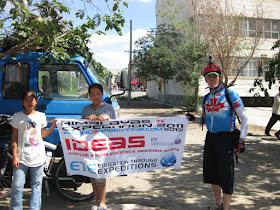

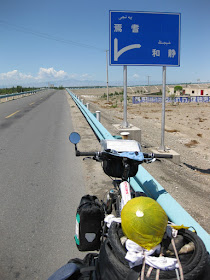

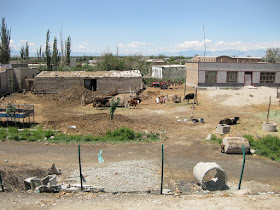























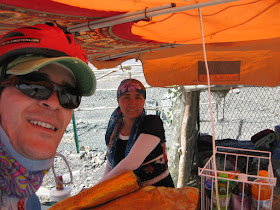







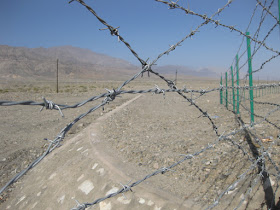


















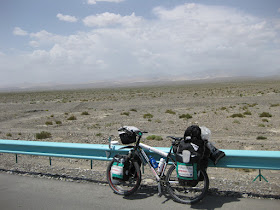







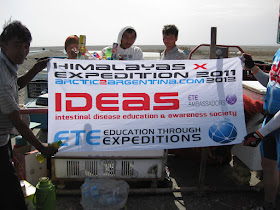
















































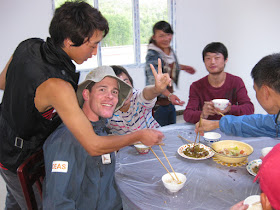
















































No comments:
Post a Comment
Have a comment or suggestion - Please leave a message!